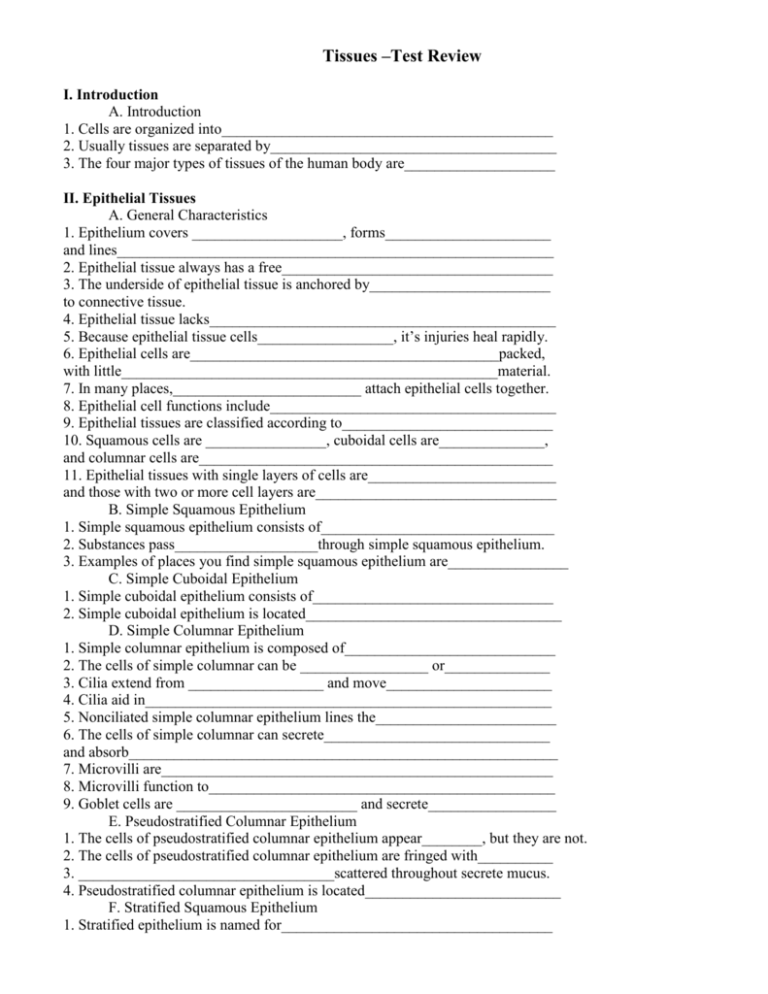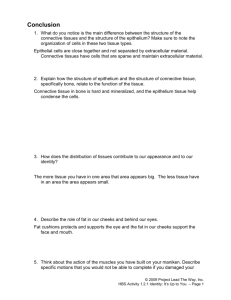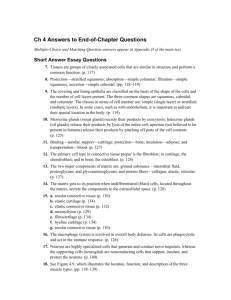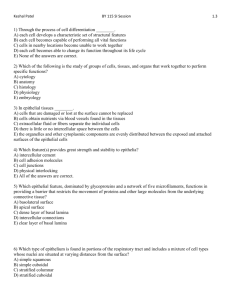Tissues Test Review
advertisement

Tissues –Test Review I. Introduction A. Introduction 1. Cells are organized into____________________________________________ 2. Usually tissues are separated by______________________________________ 3. The four major types of tissues of the human body are____________________ II. Epithelial Tissues A. General Characteristics 1. Epithelium covers ____________________, forms______________________ and lines__________________________________________________________ 2. Epithelial tissue always has a free____________________________________ 3. The underside of epithelial tissue is anchored by________________________ to connective tissue. 4. Epithelial tissue lacks______________________________________________ 5. Because epithelial tissue cells__________________, it’s injuries heal rapidly. 6. Epithelial cells are_________________________________________packed, with little__________________________________________________material. 7. In many places,_________________________ attach epithelial cells together. 8. Epithelial cell functions include______________________________________ 9. Epithelial tissues are classified according to____________________________ 10. Squamous cells are ________________, cuboidal cells are______________, and columnar cells are_______________________________________________ 11. Epithelial tissues with single layers of cells are_________________________ and those with two or more cell layers are________________________________ B. Simple Squamous Epithelium 1. Simple squamous epithelium consists of_______________________________ 2. Substances pass___________________through simple squamous epithelium. 3. Examples of places you find simple squamous epithelium are________________ C. Simple Cuboidal Epithelium 1. Simple cuboidal epithelium consists of________________________________ 2. Simple cuboidal epithelium is located__________________________________ D. Simple Columnar Epithelium 1. Simple columnar epithelium is composed of____________________________ 2. The cells of simple columnar can be _________________ or______________ 3. Cilia extend from __________________ and move______________________ 4. Cilia aid in______________________________________________________ 5. Nonciliated simple columnar epithelium lines the________________________ 6. The cells of simple columnar can secrete______________________________ and absorb_________________________________________________________ 7. Microvilli are____________________________________________________ 8. Microvilli function to______________________________________________ 9. Goblet cells are ________________________ and secrete_________________ E. Pseudostratified Columnar Epithelium 1. The cells of pseudostratified columnar epithelium appear________, but they are not. 2. The cells of pseudostratified columnar epithelium are fringed with__________ 3. __________________________________scattered throughout secrete mucus. 4. Pseudostratified columnar epithelium is located__________________________ F. Stratified Squamous Epithelium 1. Stratified epithelium is named for____________________________________ 2. Cells nearest the free surface of stratified squamous are__________________, while cells in the deeper layers are______________________________________ 3. Stratified squamous that accumulates keratin is located___________________ 4. Keratin is_______________________________________________________ 5. Keratinization produces____________________________________________ 6. Stratified squamous epithelium that does not accumulate keratin is located_______ G. Stratified Cuboidal Epithelium 1. Stratified cuboidal epithelium consists of______________________________ 2. Stratified cuboidal epithelium is located__________________________________ H. Stratified Columnar Epithelium 1. Stratified columnar epithelium consists of_________________________________ 2. Stratified columnar epithelium is located__________________________________ 1. Transitional epithelium is specialized to_______________________________ 2. Transitional epithelium forms the lining of_______________________________ 3. When the wall of the bladder contracts, the transitional epithelium consists of __ 4. When the wall of the bladder is distended, the transitional epithelium_________ J. Glandular Epithelium 1. Glandular epithelium is composed of cells that are specialized______________ 2. Exocrine glands secrete their products into_____________________________ 3. Endocrine glands secrete their products into____________________________ 4. An example of a unicellular exocrine gland is___________________________ 5. Multicellular exocrine glands are divided into____________________________ 6. A simple gland has an_________duct while a compound gland has a ______duct. 7. Tubular glands are________________________________________________ 8. Alveolar glands are_______________________________________________ 9. Merocrine glands release___________________________________________ 10. Apocrine glands release___________________________________________ 11. Holocrine glands release__________________________________________ 12. The secretion of a serous cell is_____________________________________ 13. The secretion of a mucus cell is_____________________________________ III. Connective Tissues A. General Characteristics 1. Connective tissues function to_______________________________________ 2. Matrix of connective tissue is_______________________________________ 3. Matrix consists of_________________________________________________ 4. Connective tissues have varying degrees of____________________________ B. Major Cell Types 1. Examples of fixed cells are_________________________________________ 2. An example of a wandering cell is____________________________________ 3. _______________is the most common kind of fixed cell in connective tissues. 4. Fibroblasts produce_______________________________________________ 5. Macrophages originate as__________________________________________ 6. Macrophages are specialized to carry out______________________________ 7. Mast cells are usually located near___________________________________ 8. Heparin functions to_______________________________________________ 9. Histamine functions to_____________________________________________ C. Connective Tissue Fibers 1. The three types of fibers produced by fibroblasts are______________________ 2. Collagenous fibers are_____________________________________________ 3. Collagenous fibers have_____________________________________strength. 4. Collagenous fibers are important components of_________________________ 5. Dense connective tissue contains abundant_____________________________ 6. Loose connective tissue has sparse___________________________________ 7. Elastic fibers are composed of_______________________________________ 8. Elastic fibers are common in body parts that____________________________ 9. Examples of places you find elastic fibers are_____________________________ 10. Reticular fibers are very thin_______________________________________ 11. They are _______________________ and form__________________________ D. Categories of Connective Tissues 1. The two categories of connective tissues are______________________________ 2. Connective tissue proper includes______________________________________ 3. Specialized connective tissue includes__________________________________ E. Loose Connective Tissue 1. Loose connective tissue is located_____________________________________ 2. Most cells of loose connective tissue are_______________________________ 3. Loose connective tissue functions to___________________________________ F. Adipose Tissue 1. Adipocytes are___________________________________________________ 2. Adipose tissue is located____________________________________________ 3. Adipose tissue functions to__________________________________________ G. Reticular Connective Tissue 1. Reticular connective tissue is composed of______________________________ 2. Reticular connective tissue supports___________________________________ H. Dense Connective Tissue 1. Dense connective tissue consists of___________________________________ 2. Subclasses of dense connective tissue are______________________________ 3. Regular dense connective tissue binds________________________________ 4. Irregular dense connective tissue is located____________________________ I. Elastic Connective Tissue 1. Elastic connective tissue consists of__________________________________ 2. Elastic connective tissue is located___________________________________ J. Cartilage 1. Cartilage is a_____________________________________connective tissue. 2. Cartilage provides________________________________________________ 3. Cartilage matrix is composed of_____________________________________ 4. Cartilage cells are called___________________________________________ 5. Lacunae are_____________________________________________________ 6. Perichondrium is_________________________________________________ 7. Cartilage lacks___________________________________________________ 8. Three types of cartilage are_________________________________________ 9. The most common type of cartilage is_________________________________ 10. Hyaline cartilage has__________________________________in its matrix. 11. Hyaline cartilage is located________________________________________ 12. Elastic cartilage has___________________________________in its matrix. 13. Elastic cartilage is located_________________________________________ 14. Fibrocartilage has_____________________________________in its matrix. 15. Fibrocartilage is located___________________________________________ K. Bone 1. Bone is the most___________________________________connective tissue. 2. The hardness of bone is due to_______________________________________ 3. Bone functions to_________________________________________________ 4. Bone cells are____________________________________________________ 5. Lamella are______________________________________________________ 6. Osteocytes form_______________________________around a central canal. 7. An osteon is_____________________________________________________ 8. A central canal of an osteon contains_________________________________ 9. Canaliculi are____________________________________________________ 10. _________________________________________extend through canaliculi. 11. ___________________________attach osteocyte cellular processes together so that materials can_________________________________________________ L. Blood 1. Blood is composed of______________________________________________ 2. Plasma is_______________________________________________________ 3. Cell types of blood are_____________________________________________ 4. Red blood cells function to_________________________________________ 5. White blood cells function to________________________________________ 6. Platelets function to_______________________________________________ IV. Muscle Tissues A. General Characteristics 1. Cells in muscle tissues are called_____________________________________ due to their________________________________________________________ 2. Muscle tissues are________________, meaning they can shorten and thicken. 3. The three types of muscle tissue are__________________________________ B. Skeletal Muscle Tissue 1. Skeletal muscle tissue forms________________________________________ 2. Skeletal muscle tissue is under conscious control and is therefore called______ 3. Striations of skeletal muscle tissue are________________________________ 4. Skeletal muscle tissue functions to___________________________________ C. Smooth Muscle Tissue 1. Smooth muscle tissue is called smooth because_________________________ 2. Smooth muscle tissue is located______________________________________ 3. Smooth muscle is involuntary because________________________________ D. Cardiac Muscle Tissue 1. Cardiac muscle tissue is located_____________________________________ 2. An intercalated disc is_____________________________________________ 3. Like skeletal muscle, cardiac muscle is________________________________ 4. Like smooth muscle, cardiac muscle is________________________________ V. Nervous Tissues A. Nervous tissues are found_______________________________ B. The basic cells of nervous tissue are_______________________ C. In addition to neurons, nervous tissue also includes___________ VI. Types of Membranes A. Epithelial membranes are composed of____________________ B. Three types of epithelial membranes are______________________ C. Serous membranes line____________and secrete_________fluid. D. Mucous membranes line________________and secrete________ E. The cutaneous membrane is also called________________









